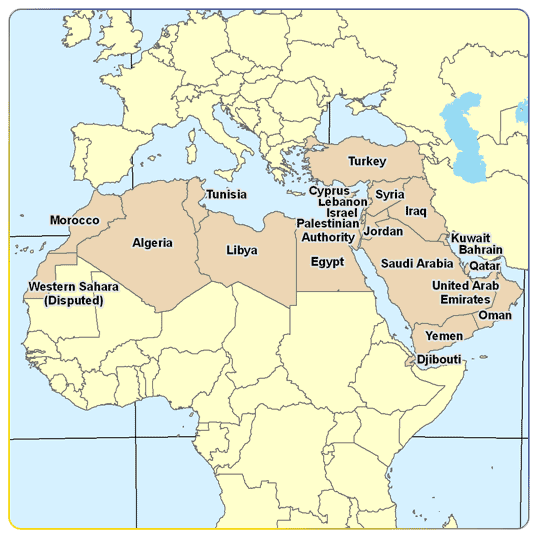|
Welcome To The Online Home Of
GABRIEL G TABARANI
where you will find all necessary information concerning his publications, which are concentrating on Middle East and North Africa.
| |
As Gabriel G. Tabarani's books are on the Middle East and North Africa, it will be useful before reading his new releases to know some information about the two areas. |
|
|

|
The Middle East is a subcontinent with no clear boundaries, often used as a synonym to Near East, in opposition to Far East. The term "Middle East" was popularized around 1900 in the United Kingdom; it has a loose definition traditionally encompassing countries or regions in Western Asia and parts of North Africa. The corresponding adjective to Middle East is Middle-Eastern and the derived noun is Middle-Easterner.
The history of the Middle East dates back to ancient times, and throughout its history the Middle East has been a major centre of world affairs. The Middle East is also the geographic origin of three of the world’s major religions - Christianity, Islam and Judaism. The Middle East generally has an arid and hot climate, with several major rivers providing for irrigation to support agriculture in limited areas. Many countries located around the Arabian Gulf have large quantities of crude oil. In modern times the Middle East remains a strategically, economically, politically, culturally, and religiously sensitive region.
The term "Middle East" may have originated in the 1850s in the British India Office, and became more widely known when American naval strategist Alfred Thayer Mahan used the term. During this time the British and Russian Empires were vying for influence in Central Asia, a rivalry which would become known as The Great Game. Mahan realized not only the strategic importance of the region, but also of its center, the Persian Gulf. He labeled the area surrounding the Persian Gulf as the Middle East, and said that after the Suez Canal, it was the most important passage for Britain to control in order to keep the Russians from advancing towards India. Mahan first used the term in his article "The Persian Gulf and International Relations," published in September 1902 in the National Review, a British journal: “The Middle East, if I may adopt a term which I have not seen, will some day need its Malta, as well as its Gibraltar; it does not follow that either will be in the Persian Gulf. Naval force has the quality of mobility which carries with it the privilege of temporary absences; but it needs to find on every scene of operation established bases of refit, of supply, and in case of disaster, of security. The British Navy should have the facility to concentrate in force if occasion arise, about Aden, India, and the Persian Gulf.”
Mahan's article was reprinted in The Times and followed in October by a 20 article series entitled "The Middle Eastern Question," written by Sir Ignatius Valentine Chirol. During this series Sir Ignatius expanded the definition of the "Middle East" to include "those regions of Asia which extend to the borders of India or command the approaches to India." With the series end in 1903, The Times removed quotation marks from subsequent uses of the term.
Until World War II, it was customary to refer to areas centered around Turkey and the eastern shore of the Mediterranean as the "Near East," while the "Far East" centered on China. The Middle East then meant the area from Mesopotamia to Burma, namely the area between the Near East and the Far East. The sense described in this article evolved during the war, perhaps influenced by the ancient idea of the Mediterranean as the "sea in the middle".
One widely used definition of the "Middle East" is that of the airline industry, maintained by the IATA standards organization. This definition — as of early 2007 — includes Afganistan, Bahrain, Egypt, Iran, Iraq, Israel, Jordan, Kuwait, Lebanon, Pakistan, Palestinian Territories, Oman, Qatar, Saudi Arabia, Sudan, Syria, United Arab Emirates, and Yemen. This definition is used in worldwide airfare and tax calculations for passengers and cargos.
On the other hand, it is customary to refer to North Africa area which includes Algeria, Libya, Mauritania,Morroco and Tunisia.
|

